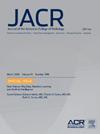Causes of Moral Distress in Academic Radiologists: Variation Among Institutions
IF 5.1
3区 医学
Q1 RADIOLOGY, NUCLEAR MEDICINE & MEDICAL IMAGING
引用次数: 0
Abstract
Purpose
To assess whether causes of moral distress vary by academic institution. Moral distress is experienced when health care providers are unable to provide the right care to patients because of institutional or resource constraints.
Materials and methods
A survey was performed based on Moral Distress Scale-Revised for Health Care Professionals for 16 clinical scenarios assessing frequency and severity of moral distress among academic radiologists. The survey was sent to members of the RSNA Quality Improvement Committee for distribution to their department. Measure of Moral Distress for Health Care Professionals (MMD-HP) was calculated for individuals and moral distress index for clinical scenarios. MMD-HP were compared by sex, ethnicity, age, years of practice, weekly work hours, practice setting or type, and consideration of leaving the workplace. Statistical analysis was performed using Kruskal-Wallis test and Kendall ordinal correlation.
Results
In all, 126 respondents from five institutions from five different states were included in the analysis. MMD-HP ranged from 24 to 66 (maximum 266). Median MMD-HP was higher in radiologists working >60 hours per week (59 versus 32.5, P = .048). Radiologists across institutions consistently reported four main sources of moral distress: pressure to perform unsafe numbers of studies (108 of 126, 85%), high workloads impeding resident teaching (102 of 126, 81%), lack of administrative support for patient care issues (102 of 126, 81%), and pressure to conduct unnecessary imaging (111 of 126, 88%). Higher MMD-HPs correlated significantly with job turnover intentions or past job changes (P < .001). The average percentage of radiologists with an intention to leave or having left as position was 44% with a range of 26% to 84%.
Conclusion
Moral distress is pervasive in radiology, with four primary causes consistently identified across academic institutions. Strong association between higher moral distress levels and job turnover intentions highlights its impact on workforce retention.
学术放射科医师道德困境的原因:机构间的差异。
目的:评估道德困境的原因是否因学术机构而异。当卫生保健提供者由于机构或资源限制而无法向患者提供正确的护理时,就会经历道德痛苦。材料与方法:采用《卫生保健专业人员道德困扰量表》对16种临床情景进行调查,评估学术放射科医师道德困扰的频率和严重程度。该调查被发送给RSNA质量改进委员会的成员,以分发给他们的部门。计算个体的道德困扰量表(MMD-HP)和临床情景的道德困扰指数。通过性别、种族、年龄、实践年数、每周工作时间、实践环境或类型以及离开工作场所的考虑来比较MMD-HP。采用Kruskal-Wallis检验和Kendall序数相关进行统计分析。结果:总共有来自五个不同州的五个机构的126名受访者被纳入分析。MMD-HP范围从24到66(最大266)。放射科医生每周工作60小时的MMD-HP中位数较高(59比32.5,P = 0.048)。各机构的放射科医生一致报告了四个主要的道德困扰来源:进行不安全研究的压力(126人中有108人,85%),高工作量阻碍住院医师教学(126人中有102人,81%),缺乏对患者护理问题的行政支持(126人中有102人,81%),以及进行不必要的成像的压力(126人中有111人,88%)。较高的mmd - hp与离职意向或过去的工作变动显著相关(P < 0.001)。打算离职或已经离职的放射科医生的平均百分比为44%,范围为26%至84%。结论:道德困扰在放射学中普遍存在,各学术机构一致认为有四个主要原因。较高的道德困扰水平与离职意愿之间的强烈联系突出了其对劳动力保留的影响。
本文章由计算机程序翻译,如有差异,请以英文原文为准。
求助全文
约1分钟内获得全文
求助全文
来源期刊

Journal of the American College of Radiology
RADIOLOGY, NUCLEAR MEDICINE & MEDICAL IMAGING-
CiteScore
6.30
自引率
8.90%
发文量
312
审稿时长
34 days
期刊介绍:
The official journal of the American College of Radiology, JACR informs its readers of timely, pertinent, and important topics affecting the practice of diagnostic radiologists, interventional radiologists, medical physicists, and radiation oncologists. In so doing, JACR improves their practices and helps optimize their role in the health care system. By providing a forum for informative, well-written articles on health policy, clinical practice, practice management, data science, and education, JACR engages readers in a dialogue that ultimately benefits patient care.
 求助内容:
求助内容: 应助结果提醒方式:
应助结果提醒方式:


